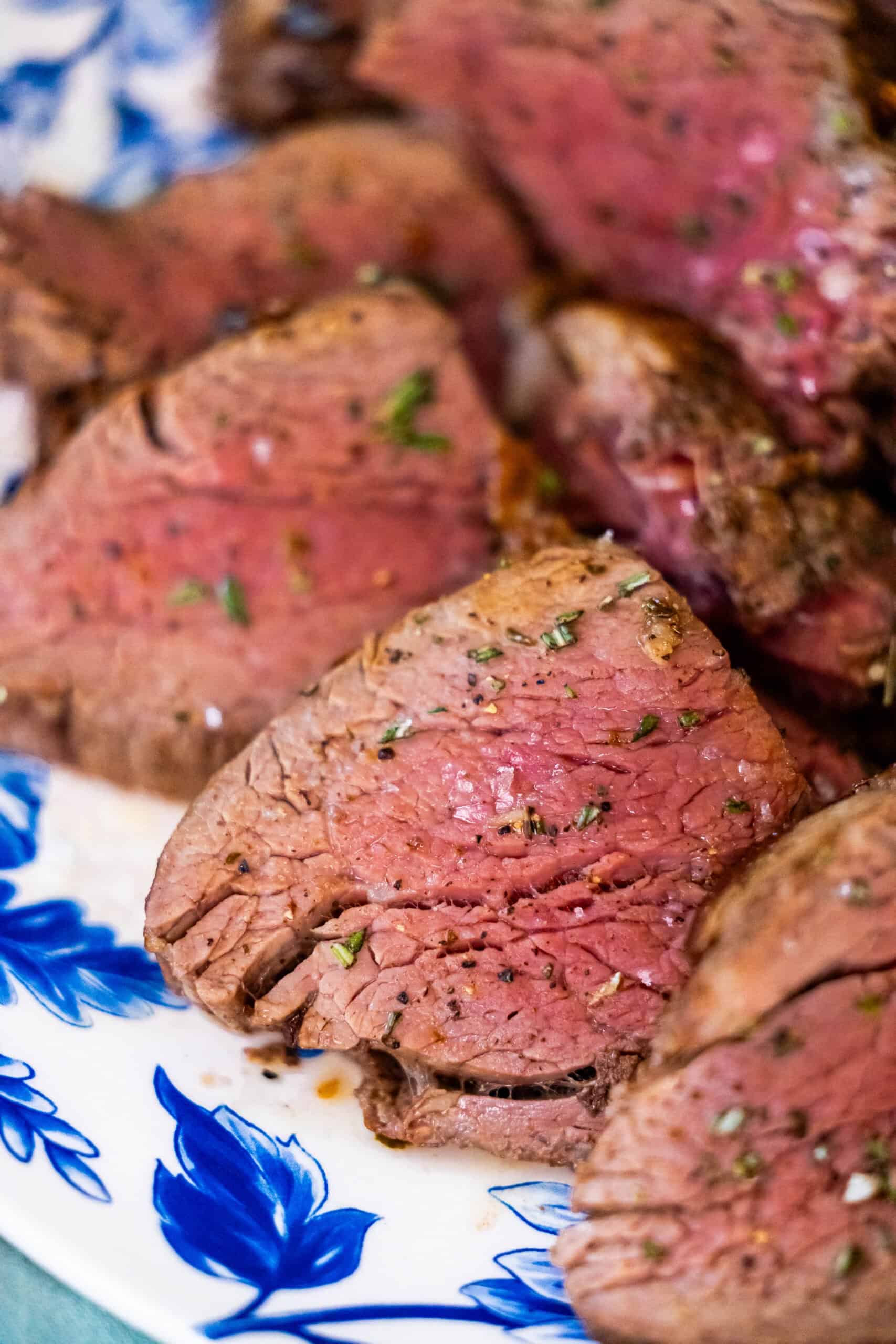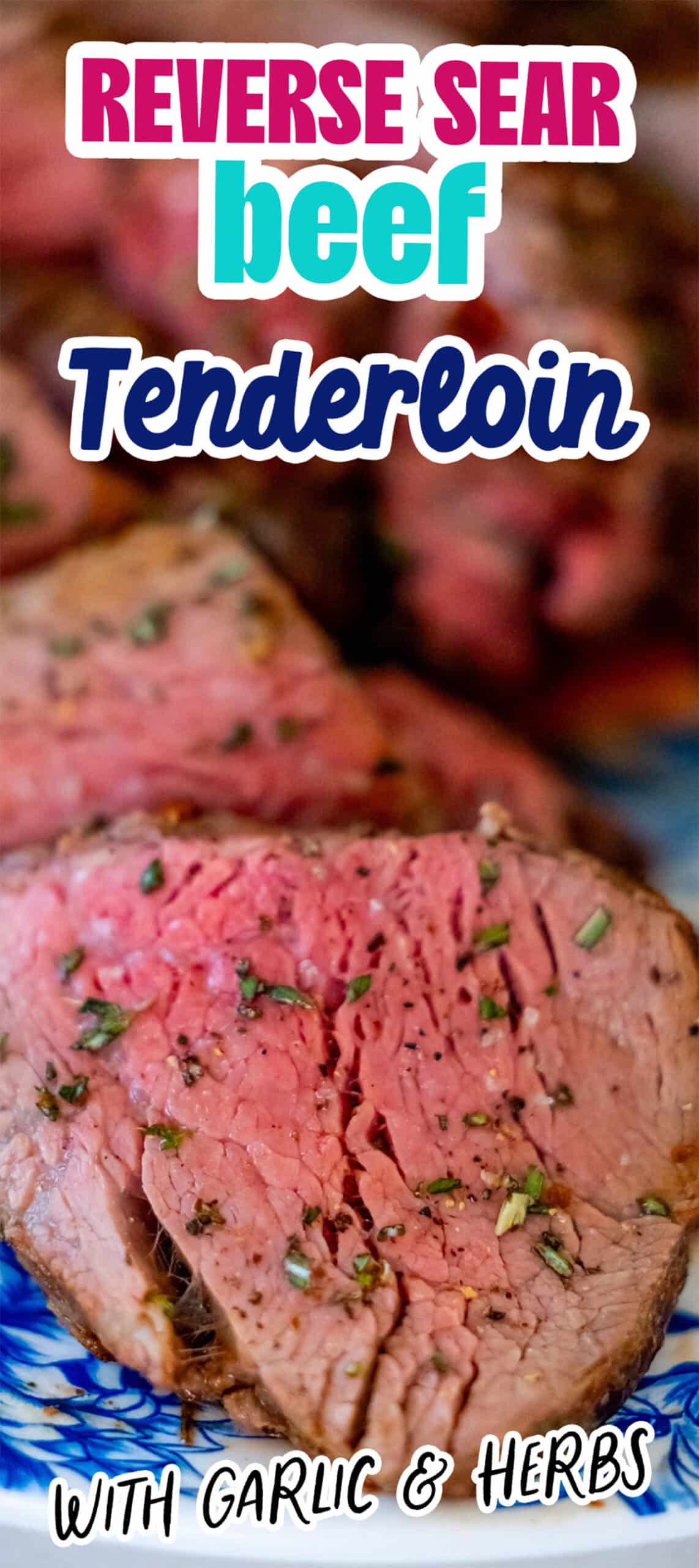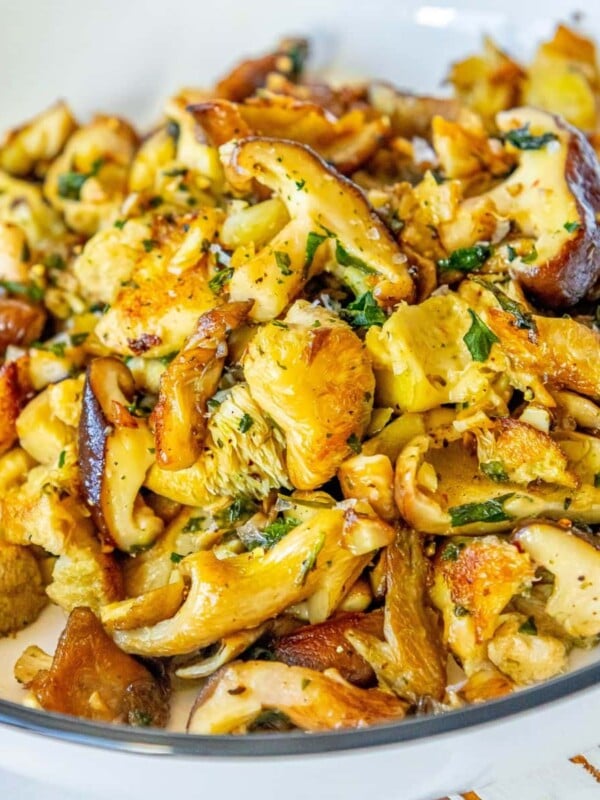This post contains affiliate links. Please read our disclosure policy.
Beef Tenderloin is one of those holiday dinners you can’t get enough of – it’s rich and hearty – but nobody needs to know my Reverse Sear Beef Tenderloin recipe is also incredibly easy to make!

Don’t want all the extras in a recipe post? We provide a skip to recipe button in the top left corner, as well as a clickable table of contents, just below, to help make this page easier to navigate.
At Sweet C’s, I add lots of tips in all of my recipes – because I am a home cook without any formal training, and I find I am more confident making dishes when I understand why it works, and what each ingredient means to the flavor of a recipe. My goal is for even the most beginner home cook to feel empowered in the kitchen.
Table of Contents

How to Reverse Sear Beef Tenderloin
First, we will need to gather the following ingredients:
- Beef Tenderloin: Mildly beefy, rich, and extremely tender; the luxurious centerpiece of the dish.
- Salt and Black Pepper: Enhances natural flavors; adds balance and a flavorful crust.
- Olive Oil or Neutral Oil: Ensures even cooking, forms a golden crust, and adds richness.
- Garlic: Bold, aromatic, and savory with a slight sweetness; deepens flavor.
- Rosemary and Thyme: Woody, piney, and earthy; adds aromatic complexity and complements the beef.





Once you’ve gathered your ingredients we will use the following process:
- Prepare the Beef Tenderloin: Trim any excess fat or silver skin from the tenderloin if not already done. Tie the tenderloin with butcher’s twine at 1-inch intervals to ensure even cooking. Season generously with salt and pepper (and any other preferred spices). For the best flavor, season at least 1–2 hours in advance or overnight in the fridge.
- Preheat the Oven: Set your oven to 225°F (110°C) for a slow and even cook.
- Cook the Tenderloin (Low and Slow): Place the tenderloin on a wire rack set over a baking sheet. This allows air to circulate around the meat for even cooking. Insert a meat thermometer into the thickest part of the tenderloin.
- Roast in the oven until it reaches your desired doneness (This usually takes about 30 minutes per pound.):
- 120°F (49°C) for rare
- 130°F (54°C) for medium-rare
- 140°F (60°C) for medium
- This will take about 1.5–2 hours, depending on the size of your tenderloin.
- Rest the Meat: Remove the tenderloin from the oven and let it rest for 10–15 minutes. The internal temperature will rise slightly during this time (carryover cooking).
- Sear the Tenderloin (Hot and Fast): Heat a large skillet or cast-iron pan over high heat until smoking hot. Add a thin layer of oil to the pan. Sear the tenderloin on all sides, about 1–2 minutes per side, until a golden-brown crust forms. For extra flavor, you can add butter, crushed garlic, and herbs (rosemary, thyme) to the pan during the sear, spooning the butter over the meat.
- Slice and Serve: Remove the twine, slice into thick medallions, and serve immediately. Optional: Drizzle with a simple pan sauce or garnish with fresh herbs.

Tips for Perfect Juicy Reverse Seared Tenderloin
Choose a Uniform Tenderloin: Trim and tie your tenderloin to create an even shape. This helps it cook uniformly.
Season Generously: Salt the meat generously and let it rest uncovered in the refrigerator for a few hours or overnight. This dry brining enhances flavor and promotes a better crust.
Use a Meat Thermometer: For precision, use a digital thermometer to monitor the internal temperature throughout the process. It’s essential for perfect doneness.
Cooking Low and Slow
Preheat the Oven to a Low Temperature: Set your oven to 225–250°F (107–121°C). A low temperature ensures even cooking and prevents overcooking.
Cook to Almost Desired Temperature: Roast the tenderloin in the oven until it’s 10–15°F below your target doneness:
- Medium-rare: 120–125°F
- Medium: 130–135°F
Rest the Meat After Roasting: Remove the tenderloin from the oven and let it rest for 10–15 minutes. Resting allows the juices to redistribute and prevents overcooking during the searing step.
Searing for the Perfect Crust
Use a Cast-Iron Skillet: Heat a cast-iron skillet over high heat for even, intense heat.
Use High-Heat Oil: Sear with a high-smoke-point oil like avocado, grapeseed, or vegetable oil to prevent burning.
Sear Quickly: Sear each side of the tenderloin for 1–2 minutes until a deep, golden-brown crust forms. Avoid over-searing to maintain your desired doneness.
Flavor Enhancements
Add Aromatics During Searing: Toss in butter, minced garlic, and fresh herbs (like rosemary or thyme) during the final searing. Spoon the infused butter over the tenderloin for an extra layer of flavor.
Finish with a Sauce or Glaze: Serve with a pan sauce, chimichurri, or balsamic glaze to enhance the tenderloin’s flavor profile.
Slice Just Before Serving:
Slice the tenderloin into thick medallions only after the reverse-searing process to retain juices.
Keep in mind that the internal temperature will rise slightly after searing, so plan accordingly.
FAQs
Reverse searing is a cooking method where you slowly cook the meat at a low temperature first to ensure even doneness throughout, then finish by searing it in a hot pan or grill to create a flavorful crust.
Beef tenderloin is a lean, tender cut that benefits from gentle cooking to prevent overcooking and drying out. Reverse searing ensures the center stays juicy and perfectly cooked while the crust is rich and caramelized.
Medium-rare: 130°F (54°C)
Rare: 120°F (49°C)
Medium: 140°F (60°C)
The meat’s temperature will rise slightly (about 5°F) during resting, so remove it from the oven when it’s 5°F below your desired final temperature.
It takes about 1.5–2 hours to cook the tenderloin in the oven, depending on the size and desired doneness. The searing step takes an additional 5–10 minutes.
Meat Thermometer: Essential for monitoring internal temperature.
Wire Rack: Keeps the meat elevated for even airflow during the low-temperature cook.
Cast-Iron (or other heavy) Pan: Ideal for searing due to its heat retention.
Yes. Tying the tenderloin with butcher’s twine ensures even thickness, which promotes even cooking and prevents thin ends from drying out.
Yes, seasoning in advance (1–2 hours or overnight) allows the salt to penetrate the meat, enhancing flavor. For best results, store it uncovered in the fridge to dry the surface slightly for better searing.
Yes, resting the meat for 10–15 minutes after roasting allows juices to redistribute and prevents overcooking during the sear.
Use a high-smoke-point oil, such as canola, avocado, or vegetable oil, olive oil works but should not be cooked past its smokepoint. Butter can be added at the end for flavor, but it burns quickly if used alone.
You can cook the tenderloin to the desired internal temperature, let it cool, and store it in the fridge. When ready to serve, reheat briefly in a low oven (200°F/90°C) and then sear.
Pat the tenderloin dry before searing.
Use a very hot skillet or grill.
Don’t overcrowd the pan—leave room for airflow.
Avoid moving the meat too much while it sears.
Yes, the same technique applies to smaller cuts or individual steaks. Just reduce the cooking time and monitor the internal temperature closely.
Creamy mashed potatoes
Roasted vegetables (carrots, asparagus, or Brussels sprouts)
Yorkshire pudding
Red wine or mushroom sauce
Fresh salads with vinaigrette
Store leftover beef tenderloin in an airtight container in the fridge for up to 3 days. Reheat gently in a low oven or enjoy cold in sandwiches or salads.

What to Serve With Reverse Seared Beef Tenderloin

Reverse Sear Beef Tenderloin

Equipment
Ingredients
- 5 lbs beef tenderloin, whole, trimmed, and tied
- 1 tsp sea salt
- ¼ tsp black pepper, ground
- 3 tbsp olive oil or neutral cooking oil
- 4 cloves garlic, minced
- 1 tbsp fresh rosemary, chopped
- 1 tbsp fresh thyme, chopped
Instructions
- Preheat your oven to 225°F (107°C). Line a baking sheet with foil and place a wire rack on top.
- Pat the tenderloin dry with paper towels. Season generously with salt and freshly ground black pepper, ensuring an even coating on all sides.
- Place the tenderloin on the prepared rack. Insert a meat thermometer into the thickest part of the meat.
- Roast in the oven until the internal temperature reaches 10–15°F below your desired doneness. This usually takes about 30 minutes per pound.
- Medium-rare: 120–125°F
- Medium: 130–135°F
- This will take approximately 60–90 minutes, depending on the size of your tenderloin.
- Remove the tenderloin from the oven and let it rest for 10–15 minutes. Cover loosely with foil while you prepare for searing.
- Heat a large cast-iron skillet over high heat. Add the oil and allow it to shimmer.
- Sear the tenderloin for 1–2 minutes on each side, including the ends, until a deep, golden-brown crust forms.
- Reduce the heat slightly and add the butter, minced garlic, rosemary, and thyme to the skillet.
- Spoon the melted butter and aromatics over the tenderloin as it sears to infuse flavor.
- Remove the tenderloin from the skillet and let it rest for 5–10 minutes to allow the juices to settle.
- Slice into ½-inch to 1-inch medallions and serve warm.
Nutrition
Nutrition information is automatically calculated, so should only be used as an approximation.








